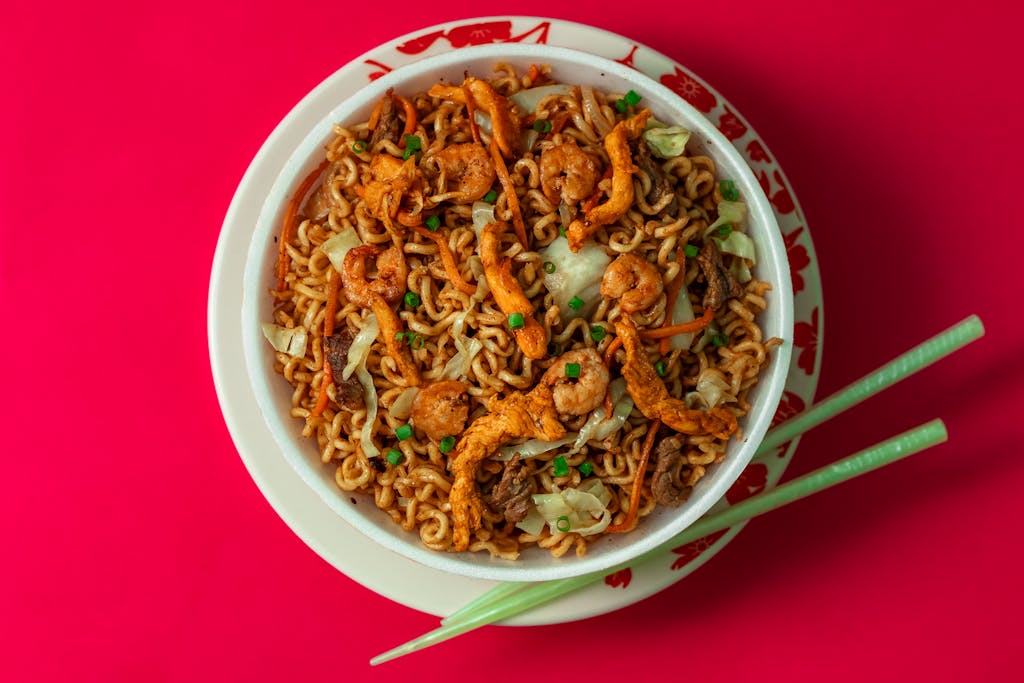Introduction to Shrimp Kadhai
Are you craving a bold, spicy dish that is quick to make yet tastes as though you spent hours preparing it? Then, shrimp kadhai will quickly become your new best friend. It is a dish that feels both indulgent and comforting at the same time, bringing together seared shrimp with a smoky tomato-onion masala that is tossed and cooked in a heavy-bottomed kadhai.

Unlike meals that take hours to develop depth of flavour, shrimp kadhai achieves its magic in a fraction of the time. The combination of caramelised onions, toasted spices, and a final squeeze of lemon creates a balance that wakes up your taste buds instantly. In many ways, it feels like a restaurant-worthy dish that you can make right at home without stress, effort, or waiting.
Order Online
What Is a Kadhai?
Before diving into the recipe, it helps to understand what makes a kadhai unique. A kadhai, also known as a karahi, is a traditional Indian cooking vessel that resembles a deep wok with rounded sides and sturdy handles. It is designed to handle high heat and quick tossing, which is why dishes cooked in a kadhai carry bold flavours and a rustic texture.
Unlike long-simmered curries that rely on slow cooking, kadhai recipes often involve quick searing, toasting of spices, and building a slightly chunky gravy that clings beautifully to the main ingredient. Shrimp fits perfectly into this method because it cooks rapidly and absorbs the strong flavours that the kadhai technique brings out.
Origin and Tradition
Kadhai cooking has deep roots in North Indian and Punjabi households, where families needed meals that were both fast and bursting with flavour. Over time, the technique travelled and adapted to regional tastes across India. In coastal areas, where seafood is abundant, cooks began experimenting with shrimp and fish in their kadhais. The result was a marriage of coastal freshness with the fiery spice mixes of the north, creating dishes like shrimp kadhai that feel both traditional and adventurous.
The Kadhai Cookware
The importance of the cookware cannot be overstated. The thick sides of a kadhai are designed to hold heat for longer periods, allowing ingredients to brown evenly while maintaining steady high temperatures. This makes it perfect for the quick searing that shrimp requires. As ingredients are tossed constantly inside, spices cling to every surface, ensuring a flavour-packed result that feels aromatic and lively in every bite.
Why Shrimp Works in a Kadhai
Shrimp is one of those ingredients that shines brightest when treated with speed and intensity. It cooks in just a few minutes, and when exposed to the kadhai’s searing heat, it locks in its natural sweetness while staying tender. The tomato-onion base paired with smoky spices provides a backdrop that highlights the shrimp’s briny flavour.
When executed correctly, every mouthful delivers a satisfying contrast between the softness of shrimp and the robust punch of the masala. Imagine the sensation of fireworks on your palate—bright, bold, and full of energy.
Key Ingredients You’ll Need
To prepare shrimp kadhai, you need fresh shrimp, ripe tomatoes, onions, bell peppers, garlic, and ginger as the base. These combine with a spice mix known as kadhai masala, which is made from freshly toasted and coarsely ground coriander seeds, cumin, fennel, and dried red chillies.
This spice mix becomes the backbone of the dish, offering warmth, depth, and fragrance. Additional flavour comes from garam masala, kasuri methi, fresh cilantro, a squeeze of lemon, and a drizzle of oil or ghee to bring everything together.
Fresh Shrimp: Choosing the Right One
The quality of the shrimp makes all the difference in the outcome. Always choose shrimp that is firm, translucent, and has a mild ocean scent. Larger shrimp handle the high heat of the kadhai better, and you can decide whether to leave the shells on for added depth or peel them for quicker absorption of flavour.
Spice Mix: Kadhai Masala
The kadhai masala is what gives this dish its character. Toasting coriander seeds, cumin seeds, fennel, and dried red chillies until they are aromatic unlocks essential oils that make the masala robust and complex. When ground coarsely, this mix contributes a toasty, rustic flavour that cannot be replicated by pre-made spice powders.
Vegetables & Aromatics
Onions lend sweetness and body to the gravy, tomatoes provide tang and structure, while bell peppers bring crunch and colour. Garlic and ginger create depth with their warm pungency, ensuring the sauce is layered and balanced. Together, these vegetables and aromatics ensure that the shrimp does not have to carry the dish alone.
Step-by-Step Shrimp Kadhai Recipe
Cooking shrimp kadhai is surprisingly straightforward once you prepare the ingredients. The dish serves three to four people and requires only about fifteen minutes of preparation, followed by a quick twelve to fifteen minutes of cooking.
Prep: Clean and Marinate
Begin by rinsing and patting the shrimp dry. Toss them with a light marinade of yoghurt or lemon juice, turmeric, red chilli powder, and salt. This marinade should rest for only ten to twenty minutes, no longer, since acidic ingredients can toughen the delicate flesh of shrimp if left too long.
Marinade Method & Timing
A standard marinade for one pound of shrimp includes a tablespoon of yoghurt or lemon juice, half a teaspoon of turmeric, a teaspoon of red chilli powder, and a teaspoon of salt. While the shrimp rests, you can toast the spices, chop onions, slice peppers, and prepare tomatoes so the cooking process moves quickly.
Cook: Sear, Toss, Simmer
Heat two tablespoons of oil or ghee in a kadhai until shimmering. Sear the shrimp in batches for about one to two minutes per side until they turn just pink, then remove and set aside. Add more oil if necessary and sauté the onions until they turn golden. At this stage, adding salt helps release their moisture. Stir in ginger and garlic, cooking until the raw aroma disappears.
Add tomatoes and cook until they break down and the oil begins to separate from the mixture. Stir in the freshly ground kadhai masala and toss the bell peppers briefly before returning the shrimp to the pan. Add a splash of water to create a light gravy and let everything simmer together for one or two minutes. Finally, finish the dish with garam masala, kasuri methi, and lemon juice.
Finishing Touches
Sprinkling fresh cilantro over the finished dish, adding a squeeze of lemon juice, and even stirring in a small pat of butter can elevate the flavours and bring a luxurious touch to the final result.
Tips for Perfect Shrimp Kadhai
The key to success lies in small details. Never overcrowd the pan, as shrimp need space to sear properly. Keep cooking time short, ideally no more than two to three minutes, to avoid a rubbery texture. If the spice level feels overwhelming, balance it with a spoon of yoghurt or a pinch of sugar. And always toast your spices fresh, because that is what gives the dish its irresistible fragrance and depth.
Variations & Twists
Shrimp kadhai is incredibly versatile, which means you can create endless variations and experiment with flavours, textures, and cooking styles while still keeping the original essence, aroma, and boldness that define this beloved dish.
Indo-Chinese Twist
By adding soy sauce, vinegar, and chilli-garlic sauce, then finishing with a smooth cornstarch slurry. The shrimp kadhai transforms into a glossy, tangy Indo-Chinese fusion that perfectly complements flavorful fried rice dishes.
Coastal / Coconut Twist
For a coastal interpretation, replace water with creamy coconut milk, toss in fragrant curry leaves. And add a tangy touch of tamarind, creating a mellow. Tropical flavour profile that beautifully echoes traditional seaside cooking.
Serving Suggestions & Pairings
Shrimp kadhai pairs wonderfully with buttered naan, steamed basmati rice, or jeera rice. To cool the palate, serve it alongside a refreshing cucumber-yoghurt raita. For beverages, a crisp lager or a citrusy white wine such as Sauvignon Blanc cuts beautifully through the spice and enhances the overall experience.
Make-ahead, Storage & Reheating
While the dish is best eaten fresh, you can prepare parts of it in advance. Store the gravy and shrimp separately for optimal results. Then reheat the gravy gently before adding the shrimp at the last minute to avoid overcooking. If reheating shrimp already mixed with the sauce, keep the flame low and heat only until warm.
Health & Nutrition Snapshot
Shrimp is naturally high in protein, low in calories, and full of nutrients like selenium and vitamin B12. To keep the dish light, use less oil, skip the butter, and increase the quantity of bell peppers and tomatoes. This way, you get a balanced meal that feels indulgent but is still wholesome.
Common Mistakes to Avoid
The most common mistake is overcooking shrimp, which makes it rubbery and unpleasant. Another is adding shrimp too early in the cooking process, which prevents them from staying tender. Skipping the step of toasting spices is also a misstep. Because it flattens the flavour and robs the dish of its signature punch.
Conclusion to Shrimp Kadhai
In essence, shrimp kadhai is proof that you do not need hours of cooking to create something extraordinary. With its quick preparation, bold spices, juicy shrimp, and smoky tomato masala. This dish feels like a small feast on any given day. Once you have mastered the classic version, experimenting with coconut milk or Indo-Chinese twists allows you to keep the excitement alive. With a kadhai in hand and shrimp sizzling over heat, magic happens in minutes. Delivering a meal that satisfies every craving.
FAQs to Shrimp Kadhai
Q1: Can I use frozen shrimp for shrimp kadhai?
Yes, frozen shrimp works fine as long as you thaw it completely and pat it dry before cooking to prevent excess water from diluting the gravy.
Q2: How long should Shrimp Kadhai marinate?
Shrimp should marinate for only ten to twenty minutes. Anything longer, especially with acidic ingredients, will toughen the flesh.
Q3: Can I make a vegetarian version?
Absolutely, you can replace shrimp with paneer, tofu. Or mushrooms and still use the same masala for a flavorful vegetarian kadhai.
Q4: How do I reduce the heat without losing taste?
If you want to tone down the spice while keeping flavour, add a spoon of yoghurt. A splash of coconut milk. Or a pinch of sugar to balance the heat.
Q5: Can I cook shrimp kadhai without a kadhai pan?
Yes, a heavy-bottomed skillet or wok works well as a substitute as long as you maintain high heat and toss the ingredients frequently.
